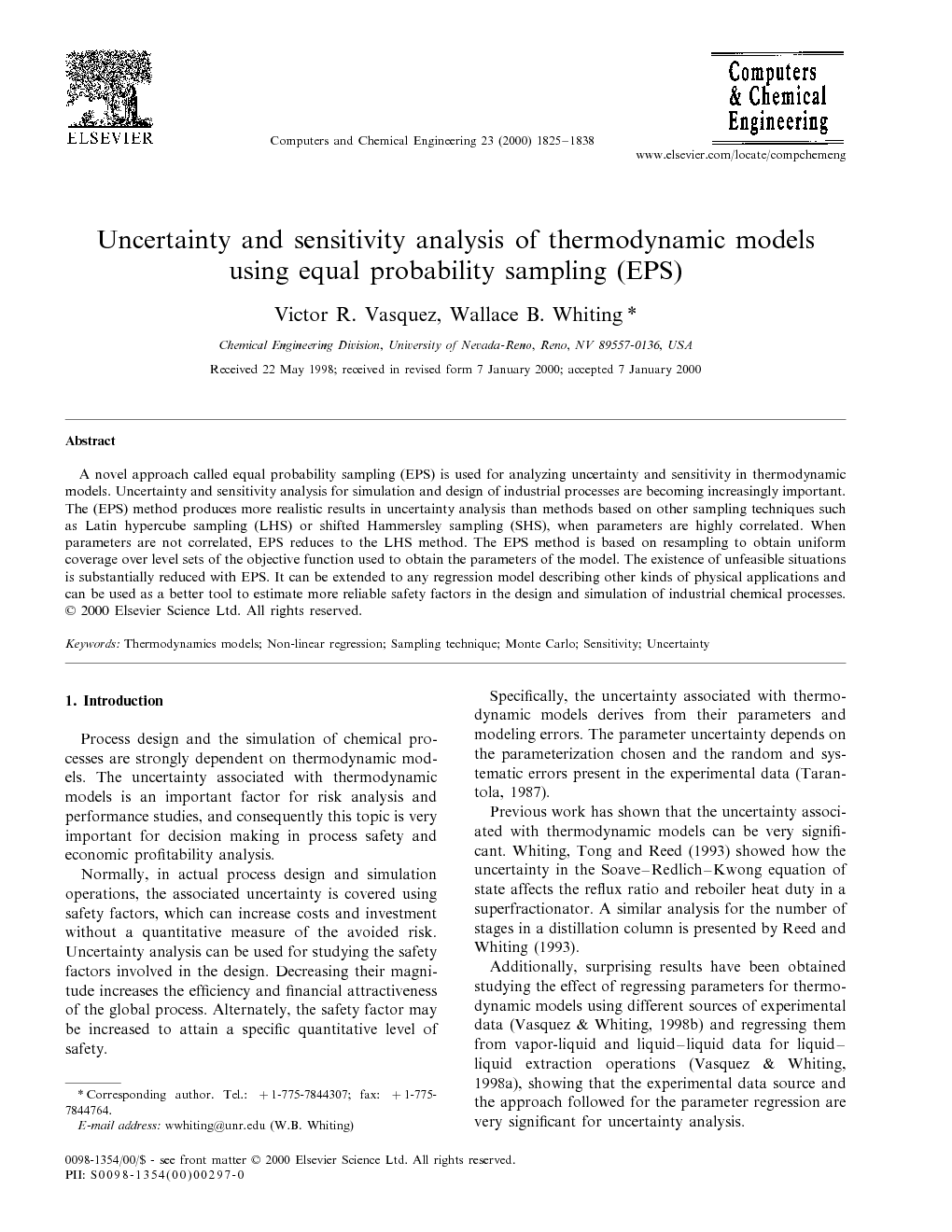A novel approach called equal probability sampling (EPS) is used for analyzing uncertainty and sensitivity in thermodynamic models. Uncertainty and sensitivity analysis for simulation and design of industrial processes are becoming increasingly important. The (EPS) method produces more realistic results in uncertainty analysis than methods based on other sampling techniques such as Latin hypercube sampling (LHS) or shifted Hammersley sampling (SHS), when parameters are highly correlated. When parameters are not correlated, EPS reduces to the LHS method. The EPS method is based on resampling to obtain uniform coverage over level sets of the objective function used to obtain the parameters of the model. The existence of unfeasible situations is substantially reduced with EPS. It can be extended to any regression model describing other kinds of physical applications and can be used as a better tool to estimate more reliable safety factors in the design and simulation of industrial chemical processes.
Process design and the simulation of chemical processes are strongly dependent on thermodynamic models. The uncertainty associated with thermodynamic models is an important factor for risk analysis and performance studies, and consequently this topic is very important for decision making in process safety and economic profitability analysis.
Normally, in actual process design and simulation operations, the associated uncertainty is covered using safety factors, which can increase costs and investment without a quantitative measure of the avoided risk. Uncertainty analysis can be used for studying the safety factors involved in the design. Decreasing their magnitude increases the efficiency and financial attractiveness of the global process. Alternately, the safety factor may be increased to attain a specific quantitative level of safety.
Specifically, the uncertainty associated with thermodynamic models derives from their parameters and modeling errors. The parameter uncertainty depends on the parameterization chosen and the random and systematic errors present in the experimental data (Tarantola, 1987).
Previous work has shown that the uncertainty associated with thermodynamic models can be very significant. Whiting, Tong and Reed (1993) showed how the uncertainty in the Soave–Redlich–Kwong equation of state affects the reflux ratio and reboiler heat duty in a superfractionator. A similar analysis for the number of stages in a distillation column is presented by Reed and Whiting (1993).
Additionally, surprising results have been obtained studying the effect of regressing parameters for thermodynamic models using different sources of experimental data (Vasquez & Whiting, 1998b) and regressing them from vapor-liquid and liquid–liquid data for liquid–liquid extraction operations (Vasquez & Whiting, 1998a), showing that the experimental data source and the approach followed for the parameter regression are very significant for uncertainty analysis.
A special concern when performing uncertainty analyses for regression models is the sampling approach used to obtain representative values from the parameter space. Traditional methods are based on stratified sampling over individual parameter distributions, and their correlation structures are approximated through the use of pairing procedures. Usually, the parameter distributions are estimated as normal with mean μ and standard deviation σ. An appropriate estimation of or can be difficult to calculate when dealing with highly nonlinear models. Examples of these methods are Latin hypercube sampling (LHS) ( Iman & Conover, 1982) and Shifted Hammersley sampling ( Kalagnanam & Diwekar, 1997). In terms of the objective function used to regress the parameters, these techniques have been shown (Vasquez, Whiting & Meerschaert, 1999) to be functionally equivalent to sampling from an approximation of a first-order in a Taylor's series expansion for the level sets. For nonlinear models (thermodynamic models belong to this category), the level sets are poorly estimated using first-order approximations when the parameter effects and intrinsic non-linearities as described by Bates and Watts, 1980 and Bates and Watts, 1981 are significant. Cook and Witmer (1985), and Seber and Wild (1989) present several examples, for simple nonlinear regression models, where the first-order approximation methods are inadequate. Mathematically speaking, these techniques are an approximation of the level sets defined by the right-hand-side of Eq. (1), which is the objective function approximated by an ellipsoid around the optimum using a Taylor development. The vector of unknown parameters is denoted by θ; θ* are the optimum parameters; H* is the Hessian of S(θ) at θ; and Vθ is the covariance matrix of θ
equation(1)
If the parameter space is not sampled properly, the values for the stochastic variables generated may not correctly represent the physical problem, producing either unlikely results or infeasible situations.
The main goal of this work is to apply the sampling approach proposed by Vasquez et al. (1999), which combines an improved level set estimation method developed by Potocký and Ban (1992) with a new resampling method along the estimated level set, to obtain more realistic output distributions of the performance or design of chemical industrial processes. The results show narrower cumulative frequency distributions than the ones obtained using traditional sampling methods, a consequence of sampling over the improved level sets obtained from the EPS technique. The NRTL and UNIQUAC models are used for the uncertainty and sensitivity analysis of several practical illustrative cases.
A novel approach for analyzing uncertainty and sensitivity in thermodynamic models with parameter correlation was implemented. The application results show a much more realistic or practical interpretation of the uncertainty present in thermodynamic models. Some of the problems present in other sampling techniques such as LHS and SHS, for example the existence of unfeasible situations, are substantially reduced or eliminated with the EPS method. The EPS technique incorporates the parameter correlation directly, rather than through pairing of uncorrelated individual parameter samples. This tool can be easily extended to any regression model describing other kinds of physical applications, and it can be used as a better tool to estimate more reliable safety factors in the design and simulation of chemical industrial process. Another possible application of EPS is in the field of design of experiments and modeling, where it can be used for improving the quality of the designs and models through the reliable prediction of the uncertainty associated with the statistical processes.


